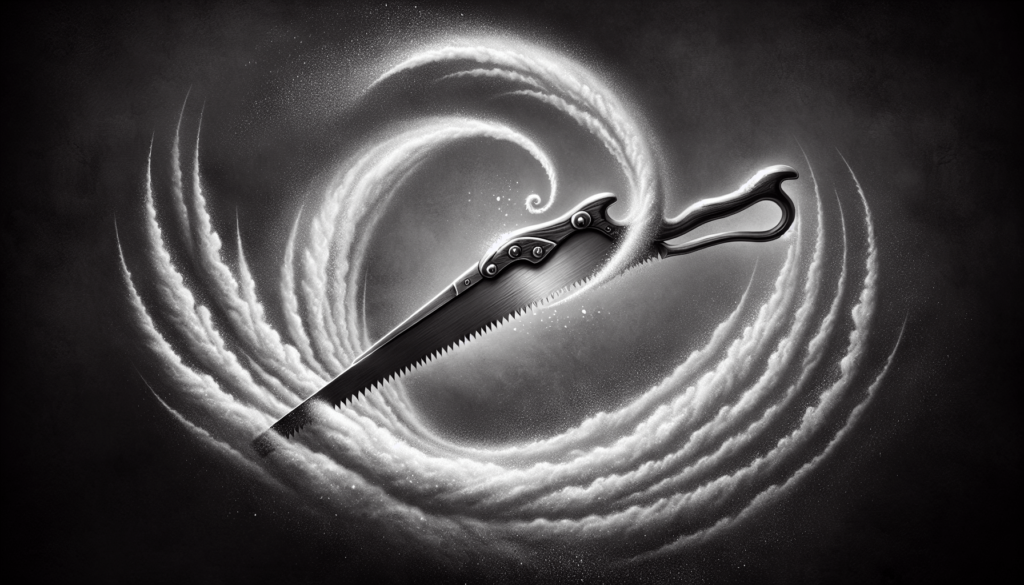Impact-Site-Verification: 1d285218-e9d8-4f5a-9745-4a9f5c09542e
Once regarded as a mundane task, sawing has transcended its practical boundaries and become an art form in itself. From the rhythmic motion of the blade to the precision required to cut through various materials, the art of sawing offers a unique experience that engages both the mind and the body. In this article, discover the fascinating world of sawing and how it has evolved from a simple technique into a captivating art form that combines skill, creativity, and the sheer joy of creating something beautiful. Sawing is a centuries-old technique that has been used by artisans, craftsmen, and DIY enthusiasts to shape, cut, and create various materials. Whether you’re working with wood, metal, or plastic, choosing the right saw for the job is crucial to ensure precision and efficiency. In this comprehensive article, we will explore different types of saws, provide tips and tricks for sawing success, discuss safety precautions, and even introduce you to prominent sawing artists and designers.
Different Types of Saws
Before we delve into the art of sawing, let’s familiarize ourselves with some of the most common types of saws.
Hand Saw
The hand saw is a classic tool that you likely have seen in your grandparent’s workshop. It features a flat, toothed blade that is manually operated by pushing and pulling back and forth. Hand saws are perfect for smaller, intricate cuts and woodworking projects that require precision.
Back Saw
Similar to a hand saw, the back saw is designed for more precise cuts. It has a rigid back that offers better control and prevents the blade from bending during the cutting process. Back saws are commonly used for making precise joinery cuts and fine woodworking.
Circular Saw
Next on our list is the circular saw, a versatile power tool that uses a toothed circular blade to cut a variety of materials. Circular saws are often used in construction and woodworking projects, as they can make both straight and angled cuts with ease.
Jigsaw
The jigsaw is a popular choice for cutting curves and intricate shapes. With a reciprocating blade that moves up and down, the jigsaw allows for great control and precision, making it ideal for woodworking, metalworking, and other crafts.
Band Saw
If you need to make intricate and irregular cuts, the band saw is your best friend. This power tool uses a continuous band of toothed metal to slice through various materials. Its versatility allows for both straight and curved cuts, making it a favorite among woodworkers, metalworkers, and craftsmen.
Now that we have covered the different types of saws, let’s move on to the next section: choosing the right saw for your project.
Choosing the Right Saw
When it comes to choosing the right saw for your project, several factors should be considered. Let’s examine these factors in detail.
Consider the Material
Different materials require different types of saws. For example, a jigsaw or band saw is better suited for cutting wood, while a metal-cutting circular saw would be more appropriate for cutting through metal. Consider the material you will be working with to determine the best saw for the job.
Consider the Cut
The type of cut you need to make also plays a role in selecting the right saw. For straight cuts, a circular saw or table saw would work well, while a jigsaw is better for curved cuts. If precision is crucial, a back saw or hand saw may be your best option.
Consider the Size and Weight
The size and weight of the saw can greatly impact your experience and the quality of your work. If you anticipate needing to move around frequently or work in tight spaces, a compact and lightweight saw would be the better choice. However, for larger projects that require power and stability, a heavier saw may be more suitable.
Consider the Blade Type
Lastly, the type of blade your saw uses can make a significant difference in the quality of your cuts. Different blade types are designed for specific materials and cutting techniques. It’s essential to choose a blade that matches the requirements of your project to ensure clean and precise cuts.
Now that you know what factors to consider when selecting a saw, let’s move on to the basic sawing techniques you should familiarize yourself with.

Basic Sawing Techniques
Sawing is more than just cutting through materials; it’s an art that requires skill and precision. Here are some basic sawing techniques that every aspiring saw user should know.
Crosscutting
Crosscutting refers to cutting a piece of material across the grain. This technique is commonly used to make square or angled cuts. To crosscut effectively, mark your desired cut line, ensure your workpiece is secure, and use your saw to make controlled, smooth strokes.
Ripping
Unlike crosscutting, ripping involves cutting along the length of the grain. It is often used to create long, straight cuts. To rip, mark your cut line, secure your workpiece, and use your saw to guide long, continuous strokes along the grain. It’s important to maintain a steady pace and apply controlled pressure throughout the process.
Mitering
Mitering involves cutting at an angle other than 90 degrees, typically for creating precise corners or joints. This technique is commonly used in carpentry and picture framing. To miter, mark your desired angle, secure your workpiece at the correct orientation, and use a miter saw or a circular saw with a miter guide to make the cuts.
Beveling
Similar to mitering, beveling also involves cutting at an angle, but this time, it is done along the edge of the material. Beveling is often used to create tapered edges or decorative finishes. To bevel, mark your desired angle, secure your workpiece at the correct angle, and use a circular saw or a jigsaw to make controlled cuts.
Dovetailing
Dovetailing is a technique commonly used in woodworking to create strong and decorative joints. It involves cutting interlocking fan-shaped projections and recesses on two pieces of material that fit together snugly. Dovetailing typically requires the use of a back saw or a dovetail saw and requires precision and practice to master.
Now that you have a good understanding of the basic sawing techniques, let’s move on to discussing some safety tips to ensure your sawing experience is both safe and enjoyable.
Safety Tips for Sawing
Safety should always be a top priority when using any type of saw. Here are some essential safety tips to keep in mind:
Wear Protective Gear
Before you start sawing, make sure to protect yourself by wearing appropriate safety gear. This should include safety glasses or goggles to protect your eyes from flying debris, ear protection to shield your hearing from loud sawing noises, and gloves to protect your hands from splinters or cuts.
Secure Your Workpiece
To prevent your workpiece from moving or slipping during the sawing process, it’s crucial to secure it properly. Depending on the type of saw you are using, this may involve using clamps, vises, or a workbench. Always ensure that your workpiece is stable and firmly held in place before making any cuts.
Maintain Proper Body Position
Maintaining the correct body position is essential for both accuracy and safety. Stand with your feet shoulder-width apart, and keep a balanced stance. Hold the saw with both hands, and position yourself so that you have good visibility of the cutting area. Avoid any awkward positions that may increase the risk of accidents.
Keep Blades Sharp and Clean
Using a dull or dirty blade not only affects the quality of your cuts but also poses a safety hazard. Dull blades require more force to cut, increasing the risk of slips or accidents. Regularly inspect your saw blades, and replace or sharpen them as needed. Additionally, clean off any debris to ensure smooth and efficient cutting.
By following these safety tips, you can minimize the risk of accidents and create a safe and enjoyable sawing experience. However, there are also some common sawing mistakes that you should be aware of and strive to avoid.

Common Sawing Mistakes to Avoid
To achieve the best results with your sawing projects, it’s important to steer clear of common mistakes that can compromise both the quality of your cuts and your safety. Let’s look at some of these mistakes and how to avoid them.
Using the Wrong Saw for the Job
Choosing the wrong saw for a specific task can lead to frustration and poor results. Make sure to consider the material, cut type, and project requirements when selecting a saw. Using the appropriate saw not only makes the task easier but also ensures cleaner and more accurate cuts.
Not Using a Guide
Failing to use a guide when making long or angled cuts can result in uneven and imprecise cuts. Always use a straight edge or a miter guide to maintain a straight line and consistent angle. This will help you achieve cleaner, more professional-looking cuts and prevent mistakes caused by hand-holding the saw.
Ignoring Safety Precautions
Safety precautions should never be ignored when working with saws. While it may be tempting to rush through a project or overlook safety gear, doing so can lead to serious injuries. Always wear the appropriate protective gear and follow safety guidelines to ensure a safe sawing experience.
Forcing the Cut
Forcing the cut is a common mistake that can cause damage to both your workpiece and your saw. Applying excessive pressure or pushing the saw forward too quickly can result in rough and inaccurate cuts. Allow the saw to do the work, and maintain a steady pace without rushing or forcing the motion.
By being mindful of these common mistakes and taking steps to avoid them, you can improve both the quality of your cuts and your overall sawing experience. However, to keep your sawing tools in top condition and ensure optimal performance, proper maintenance and care are necessary.
Maintaining and Caring for Saws
Regular maintenance and care are crucial for keeping your saws in good working order. Here are some essential maintenance tips to keep in mind:
Cleaning and Lubricating
After each use, clean your saws thoroughly to remove any debris or sawdust that may have accumulated. Use a brush or compressed air to clean hard-to-reach areas. Additionally, lubricate the moving parts of your saws with an appropriate lubricant to ensure smooth and efficient operation.
Storing Properly
Proper storage is essential for preventing damage and maintaining the longevity of your saws. Store them in a clean and dry area, ideally in a tool chest or on a dedicated storage rack. Protect the blades with blade guards or blade covers to prevent accidental contact and damage.
Sharpening and Replacing Blades
Blades can wear out over time and lose their sharpness, resulting in poor cutting performance. Regularly inspect your blades for signs of wear and tear, and sharpen or replace them as needed. Utilize the appropriate tools and techniques to ensure your blades are sharp and ready for use.
Inspecting for Damage
Before each use, inspect your saws for any signs of damage or defects. This includes checking the handles, blades, and any moving parts. If you notice any issues, such as loose parts or damaged components, repair or replace them before using the saw to prevent accidents or further damage.
By following these maintenance practices, your saws will remain in good condition, ensuring that they are ready for use whenever you need them. Now, let’s move on to discussing some advanced sawing techniques that can take your skills to the next level.

Advanced Sawing Techniques
Once you have mastered the basic sawing techniques, you may be ready to explore more advanced and intricate methods. Here are some techniques that will expand your sawing capabilities:
Scroll Sawing
Scroll sawing is a delicate and precise technique used to create intricate scrollwork and detailed designs. This technique requires using a scroll saw, which features a thin, narrow blade that moves up and down rapidly. With practice and patience, you can create stunning and complex patterns and designs.
Resawing
Resawing involves cutting a thick piece of wood into two thinner pieces. This technique allows you to create multiple pieces with the same thickness or to remove defects from a larger board. Resawing requires a bandsaw and a steady hand to achieve consistent thickness and clean cuts.
Compound Miter Cuts
Compound miter cuts are challenging but rewarding techniques used to create angled cuts on two different planes simultaneously. This technique is often employed in furniture making and trim work. Achieving precise compound miter cuts requires the use of a miter saw or a compound miter saw and careful attention to detail.
Curved Cuts
Curved cuts offer the opportunity to create flowing and artistic shapes in various materials. Whether you’re making decorative patterns or sculptural elements, curved cuts can add a unique touch to your projects. Tools such as jigsaws or bandsaws with a narrow blade can help you achieve smooth and precise curved cuts.
Joinery Cuts
Joinery cuts are essential for creating strong and seamless joints between pieces of wood. Techniques such as dado cuts, tenons, and rabbet cuts are commonly used in woodworking to create durable connections. Each joinery method requires different cuts and tools, so be sure to choose the appropriate saw and technique for your project.
These advanced techniques can be challenging, but with practice and perseverance, you can master them and take your sawing skills to new heights. Additionally, sawing skills can be applied to a variety of creative projects that go beyond traditional woodworking.
Creative Projects with Sawing
Sawing is not limited to basic construction or repair work. It can also be the foundation for a range of creative projects. Here are some avenues where you can channel your sawing skills:
Woodworking Projects
From making custom furniture to crafting unique wooden gifts, woodworking projects are a popular creative outlet that allows you to showcase your sawing skills. Whether you’re a novice or an experienced woodworker, there’s always room for creative experimentation and growth.
DIY Furniture Making
If you enjoy the satisfaction of creating your own furniture, sawing is an essential skill. By combining your sawing abilities with other woodworking techniques, you can design and build custom-made furniture pieces that perfectly fit your space and personal style.
Crafting and Sculpting
Sawing can be incorporated into various crafts and sculpting projects. Whether you’re working with wood, metal, or plastic, the ability to make precise cuts is invaluable. Use your sawing skills to create intricate details, cut out patterns, or shape materials to bring your artistic vision to life.
Home Renovations
Sawing is a valuable skill to have when it comes to home renovations. From installing new flooring to building custom cabinets or even constructing additions, the ability to make precise cuts with a saw is essential. Sawing can help transform your home and make your renovation projects more efficient and successful.
These are just a few examples of the many creative projects where sawing can play a pivotal role. Now, let’s dive into some tips and tricks that will help you make the most of your sawing endeavors.

Sawing Tips and Tricks
Whether you’re a beginner or a seasoned pro, there’s always room to improve your sawing techniques. Here are some tips and tricks to enhance your sawing skills:
Marking and Measuring
Before making any cuts, take the time to measure and mark your workpiece accurately. Use a measuring tape, square, or straightedge to ensure your measurements are precise. Double-check your markings before cutting to prevent mistakes and ensure your cuts are accurate.
Using Clamps and Guides
When making long or angled cuts, using clamps and guides will help you maintain stability and achieve consistent results. Secure your workpiece tightly using clamps or a workbench, and use a straight edge or miter guide to guide your saw along the desired path.
Controlling Saw Speed
Each saw has its own optimal cutting speed. Experiment with different speeds to find the sweet spot that allows for smooth and efficient cutting. Be mindful of the material you are working with, as different materials may require different cutting speeds for optimal results.
Mastering Straight Cuts
Straight cuts are the foundation of many sawing techniques. To ensure your straight cuts are accurate and clean, use the appropriate saw for the job, maintain a steady pace, and utilize guides or clamps to keep your workpiece in place. Practice regularly to develop a consistent cutting motion and improve your straight cutting skills.
Making Precise Angled Cuts
When making angled cuts, accuracy is key. Take the time to set up the correct angle and secure your workpiece properly. Utilize a miter guide or a bevel gauge to ensure your cuts are at the desired angle. Practice patience and precision to achieve precise angled cuts consistently.
By implementing these tips and tricks into your sawing routine, you can enhance the quality of your cuts and refine your skills. Now, let’s take a moment to appreciate some prominent artists and designers who have made significant contributions to the field of sawing.
Prominent Sawing Artists and Designers
Throughout history, numerous artists and designers have utilized sawing as a medium for their creations. Here are a few notable individuals who have left an indelible mark in the world of sawing:
Wharton Esherick
Wharton Esherick was an American artist and sculptor known for his innovative woodworking techniques. He pushed the boundaries of traditional woodworking by incorporating sculptural forms and intricate details in his furniture pieces. Esherick’s mastery of sawing allowed him to create bold and unique designs.
Sam Maloof
Sam Maloof was a renowned American furniture designer and craftsman, often referred to as the “Dean of American Woodworking.” His elegant and timeless furniture designs showcased the beauty of solid wood and showcased the importance of precise sawing techniques in creating functional and artistic pieces.
Wendy Maruyama
Wendy Maruyama is a contemporary American artist and furniture maker who combines traditional craftsmanship with conceptual and political themes. She has transformed sawing into a medium for expressing her ideas and advocating for social change. Her intricate and thought-provoking furniture pieces demonstrate the undeniable power of sawing as an artistic tool.
Laura Mays
Laura Mays is a British sculptor known for her exceptional skill in carving intricate patterns and forms from solid wood. Her work highlights the importance of precise sawing techniques in creating detailed and delicate sculptures. Mays’ craftsmanship and attention to detail have brought sawing to new artistic heights.
Alison Kinnaird
Alison Kinnaird is a Scottish artist and glass sculptor who has mastered the technique of sawing intricate patterns into glass. By skillfully manipulating light and shadow, she creates breathtaking works of art that showcase the precision and creativity of sawing. Kinnaird’s innovative approach to sawing has revolutionized glass artistry.
These talented individuals have pushed the boundaries of sawing as an artform, inspiring countless artists and designers to explore the endless possibilities of this ancient technique. With their dedication and innovation, they remind us that sawing is not just a practical skill but also a vehicle for creativity and self-expression.
In conclusion, sawing is a versatile and essential skill that opens up endless possibilities in various fields, ranging from woodworking to sculpture. By understanding the different types of saws, mastering basic and advanced techniques, prioritizing safety, and exploring creative projects, you can become a proficient saw user. Remember to maintain and care for your saws, implement tips and tricks to improve your skills, and draw inspiration from prominent artists and designers. So, go out and embrace the art of sawing as you embark on your own exciting sawing journey!


